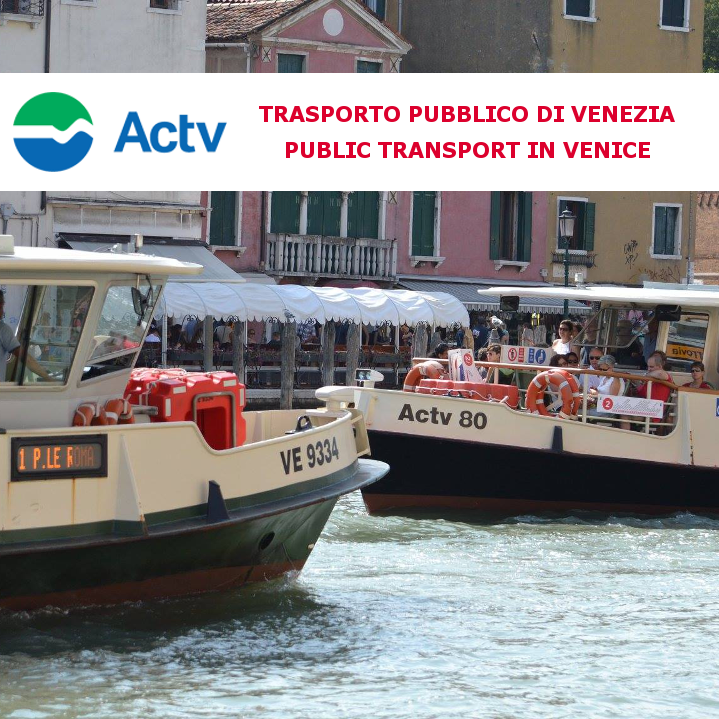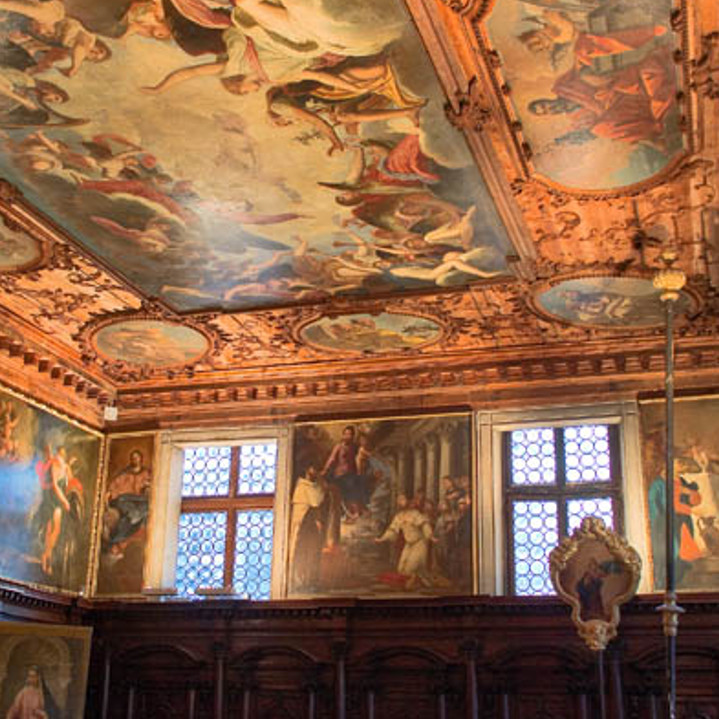You are here
Giudecca Island among art, history, tradition, industrial archaeology
Giudecca Island among art, history, tradition, industrial archaeology
This itinerary takes place on the Giudecca starting from the Palanca vaporetto stop and ending at the Zitelle stop, and aims to present the island in its most characteristic aspects through a tour that includes a visit to three artisan shops and a walk through squares, gardens, ancient industrial buildings converted into newly refurbished spaces for daily life, ancient churches and monasteries.
Giudecca is a long and narrow island that runs opposite the south side of Venice from Zattere to the San Marco Basin. Formerly called Spinalonga, the island later took the name of "Zuecca" and then Giudecca, perhaps because of the presence of a primitive community of "Zudei" (Jews) who had settled there, or perhaps because the "zudegai", that is those sentenced by the doge's courts, were confined in the area, or from "zuéc", in reference to the presence of brushwood and shrubs used by the tanners for leather processing, of which the island was rich during the Middle Ages. At the beginning of the 19th century, the island became the ideal location for the new industrial facilities that the city needed, including industrial plants, shipyards, factories, and workers' quarters, taking over its orchards, gardens, monasteries, and abandoned buildings. Today the island is a quiet residential area.
You have the chance to visit three handicraft workshops on this itinerary, starting with Itaca Art Studio by Monica Martin, a well-known and appreciated artist in town, who uses various techniques to create her paintings and pottery, which express her genuine and unique creativity. The second workshop, Murano Glass Fine Arts, produces all sorts of high-quality glass items using the lampworking technique, finally the third, Hydromirò, makes nautical interior décor and upholstery.
Along the fondamenta overlooking the canal of the Giudecca, you can find many taverns: "osterie" or "trattorias" where you can enjoy dishes made with the typical products of Venetian cuisine. Appetizers with various "cicchetti" (snacks mostly based on fish, served on bread or polenta), fish risotto, spaghetti with clams or, spaghetti with squid ink, "sarde in saor” or liver cooked the Venetian way, "baccalà mantecato” or polenta served with the "schie", grey shrimps caught in the Venetian lagoon all accompanied by a good glass of wine such as Cabernet, Pinot Grigio, Merlot.
The Site “Venice and its Lagoon” has been inscribed on the World Heritage List since 1987 due to its Outstanding Universal Value, therefore it belongs to all of us: it is our common duty to respect it and preserve it so that it may be passed on to future generations.
The cultural heritage of the Site goes beyond the walls of palaces, churches, beyond islands and the lagoon, but is also memory, identity, community, all fundamental elements for the its vitality. In 2017, the City of Venice launched #EnjoyRespectVenezia campaign to raise awareness of tourists impact among visitors inviting them to maintain a respectful and polite behaviour during their staying, respecting the city and its inhabitants: it is important for example to walk keeping on the right, not to stop and sit on the bridges, not to feed the birds, to always observe a decent attitude in keeping with the place you are visiting.
- Duration: approx. 3 hours 45 minutes
- Lenght: 4,30 km
- Mode of travel: the itinerary takes place entirely on foot
- Recommended period: all year round
- Accessibility: for people with reduced mobility we recommend the following itinerary, as there are no bridges to cross: starting from the Palanca stop, continue along fondamenta Sant'Eufemia until you reach the church by the same name, from there turn onto Fondamenta del Rio di Sant'Eufemia as far as Campo San Cosmo. After visiting the cloister of the ex-monastery and the two artisan shops suggested, proceed to Campazzo San Cosmo and then to calle del Pistor, which leads to Fondamenta Sant'Eufemia, just a short walk from the Palanca stop. Taking vaporettos 2 and 4.1, you can get off at the Redentore stop, next to the magnificent Palladio church, and continue to the Consorzio Cantieristico Minore where the third artisan shop is located, and then return to the Redentore stop. From here you can take vaporettos 2 and 4.1, get off at Zitelle and take a short quayside walk that includes the exteriors of the church of Presentazione di Maria Vergine al Tempio and Casa dei Tre Oci
- Departure: Palanca ACTV boat stop on Giudecca (accessible with lines: 2; 4.1. 4.2)
- Arrival: Zitelle ACTV boat stop (accessible with lines: 2; 4.1. 4.2)
- District: Giudecca Island overlooks the canal by the same name, opposite the Dorsoduro district, of which it is part from the administrative point of view
-
Major attractions and highlights:
1) Sant’Eufemia parish church
2) former Dreher brewery and Molino Stucky
3) Cloister and church of Saints Cosmas and Damian
4) Accademia dei Nobili and Corte dei Cordami
5) Church and Sacristy of SS. Redentore
6) Casa dei Tre Oci and Zitelle church and female asylum - Squares and rest areas: along Fondamenta Sant'Eufemia there are several bars and restaurants. In Corte Grandi there is a tree-lined urban space equipped with benches and a public play area for children. In Campo Jungans there is a bar-restaurant. Along Fondamenta San Giacomo near the Redentore church there are bars with food service. Along Fondamenta di Santa Croce near Zitelle there are some bars and small restaurants
- Pay Public toilet facilities: there are no public toilets along the itinerary
- Public drinking fountains: there are 5 public drinking fountains along the itinerary: 1. Campo San Cosmo; 2. Campiello del Forno 3. Campo Ferrando; 4. Fondamenta San Giacomo (Ponte Longo); 5. Campo del Santissimo Redentore
Listen to the audio tour

Isola della Giudecca dal campanile di San Giorgio
ph. Giorgio Bombieri - Comune di Venezia
Chiostro Santi Cosma e Damiano
ph. Giorgio Bombieri - Comune di Venezia
Stage 1: From the Palanca vaporetto stop to Campiello Priuli (35 minutes)
The walk begins at the Palanca vaporetto stop and continues towards the Molino Stucky area, along the Fondamenta di Sant'Eufemia, which takes its name from the nearby parish church founded in the 11th century in the Venetian-Byzantine style, whose original gable roof structure and three-nave basilica plan still survive today. The interior is decorated with eighteenth-century stuccoes in the Baroque style and presents works by Bartolomeo Vivarini and GB Canal.
After crossing the Sant'Eufemia bridge, you continue along the Fondamenta San Biagio towards a site featuring interesting examples of early industrial architecture such as the neo-Gothic complex of the former Dreher Brewery, built at the beginning of the 20th century and later skilfully reconverted into social housing. The renowned Fortuny fabric factory is located nearby. Founded in 1919 by the eclectic artist Mariano Fortuny, it was dedicated to the production of printed fabrics using machines and processes designed by Fortuny himself with the help of his wife Henriette.
Almost next door to Fortuny's, the Molino Stucky was built by architect Ernest Wullekopf at the behest of Giovanni Stucky, a Swiss entrepreneur and financier. Its neo-gothic facades became the reference point of Venetian industrial architecture in the second half of the nineteenth century. After a long period of total neglect, in the early 2000s, the old industrial flour mill building became part of the Hilton hotel chain thanks to complex conservative restoration that has managed to retain the old industrial structure virtually unchanged.
From Molino Stucky, you can access Calle Priuli and the nearby campiello by the same name.

Molino Stucky
ph. Giorgio Bombieri - Comune di Venezia
Stage 2: From Campiello Priuli to the monastery of Saints Cosmas and Damian (70 minutes)
From Campiello Priuli, crossing the Ponte di San Biaggio, you proceed along the length of the Fondamenta delle Convertite, which takes its name from the former monastery that stood on the banks of the canal and which, since 1857, has been converted into a female prison, as far as Campo San Cosmo where we find the sixteenth-century church dedicated to Saints Cosmas and Damian.
At the time of the Serenissima, the church housed numerous works of art created by great artists including Palma the Younger, Tintoretto, Tiepolo, Pittoni, Padovanino, Molinari, later dispersed during the Napoleonic occupation. In the course of time, the building changed its function several times until in 1895 it became a mill for the production of yarns and textiles for the company Maglierie Herion, and today, the site of the development pole for new businesses.
The former convent of Saints Cosmas and Damian, founded in 1481, stands next to the church. The nuns that lived there strictly followed the Benedictine rule and were, for the most part, noble Venetian women who brought considerable wealth as a dowry to the convent. The building became the property of the municipality of Venice in the nineteenth century and was converted into barracks, was then abandoned and became a refuge for the poor and homeless. In 1990, the municipality of Venice restored the whole convent complex creating 24 public housing residential units, 12 workshops for artists and craftsmen and the headquarters of cultural activities, such as the Centro Teatrale di Ricerca (CTR), and the Luigi Nono Archive Foundation.
In the beautiful cloister, numerous artisan workshops have found their niche, among which we would like to mention in particular: Itaca Art Studio owned by Monica Martin, one of the most appreciated artists in town who uses many techniques, showing in each one an authentic and singular creativity. To learn more, visit the website at: www.itacartstudio.com. Murano Glass Fine Arts, owned by Stefano Morasso, a master glassmaker who organizes memorable demonstrations of how to produce handcrafted glass objects. To learn more, visit the master's website at www.stefanomorasso.it and www.muranofineart.it.
Vista dal canale Santi Cosma e Damiano
ph. Comune di Venezia
Stage 3: From Campazzo San Cosmo to Corte Dei Cordami (30 minutes)
Leaving the Cloister, we proceed to the nearby Campazzo San Cosmo, a stretch of greenery with trees and flowers that opens onto Calle del Pistor, and then return to Fondamenta Sant'Eufemia in the direction of the Palanca stop.
We continue towards Ponte Piccolo, past the Accademia dei Nobili, erected in 1619 for the education of the children of Venetian patricians who had fallen into poverty, and who were educated up to the age of 20 in the arts and sciences. We walk on to Calle del Forno which, on the left, opens onto the colourful square by the same name full of flowers and plants.
Our destination is the picturesque Corte dei Cordami, once the hub of the open-air rope-making production on the island, flanked by a long building of single-storey terraced houses characterized by a sequence of 13 external chimney stacks that alternate regularly between the ground floor and the second floor and that support chimneys of various forms: funnel-shaped, block-shaped, obelisk-shaped. From here you can access Corti Grandi, a nice and quiet urban space with trees, benches and a playground for children. Nearby, the suggestive Campo Berlomoni and the adjoining Campazzo di Dentro, form an area lined with a wide variety of plants and characterized by colourful houses where time seems to stand still.
Returning to Corti Grandi and crossing the Ponte de le scuole, we reach Campo Jungans, which stands on the industrial area of the former Junghans factory, a German company that produced watches and, in wartime, bomb fuzes. The conversion of the old factory into residential buildings was entrusted to the architect Cino Zucchi in 1995, who revived the typical Venetian urban context, made of streets, squares, canals, public and private gardens, with a very innovative contemporary architecture and the reclamation of some of the structures of the previous factory converting them for residential use with commercial spaces and a theatre.
From Campo Jungans we take Calle dei Conza Curame (the tanners) leading to Fondamenta de la Palada.
Chiostro Santi Cosma e Damiano
ph. Comune di Venezia
Stage 4: From Fondamenta de la Palada to Consorzio della Cantieristica Minore (30 minutes)
Along Fondamenta de la Palada, so called because of the wooden pile breakwater that used to be on this site, you come across the wooden bridge of the Palada leading to the quaint little square called Campiello Ferrando. Fondamenta della Palada ends in front of the Sant'Angelo bridge.
Crossing the bridge, one reaches the location of many scenes of the 2020 film "Welcome Venice" by A. Segre. From here, walk down Calle delle Erbe as far as the nineteenth-century iron and steel Ponte Longo from which you can enjoy a magnificent view of the San Marco Basin. The bridge was also the set for some scenes of the 1970 film The Anonymous Venetian by E. M. Salerno.
After crossing the bridge, we walk along Fondamenta San Giacomo as far as the now-remodelled Palazzo Trevisan, also known as la Rocca Bianca, built around the end of the fifteenth century by the Visconti family of Milan. Originally, the building had a large garden, later incorporated into the nearby boatyard.
Next to this building there is the entrance to the area now occupied by the infrastructures of the Consorzio Cantieristico Minore Veneziano, the boatyard built in 1996 on the restructured warehouses and facilities of the old Cantiere Navale della Giudecca, with the reclamation of an area of approx. 3,000 sq.m, for the creation of workshops, boatyards, workshops for upholsterers, carpenters, electricians and a blacksmith foundry, together with a storage area for 350 boats.
The consortium facilities offer a good opportunity to discover the many artisan activities that occupy the restored warehouses. Here, at number 211/B, is Hydromirò, a workshop specialized in nautical upholstery, a true tailor of the sea. To learn more and arrange an appointment, please call 041.2770415.

Corte dei Cordami
ph. Comune di Venezia
Tappa 5: Redentore Church and Sacristy, Casa dei Tre Oci and Zitelle (60 minutes)
Continuing along the Fondamenta San Giacomo we arrive at the Redentore, the Church of the Redeemer, one of the greatest masterpieces by Andrea Palladio, built by the Senate of the Serenissima Republic as a votive temple to Christ the Redeemer for the end of the plague epidemic of 1575.
During the famous Festival of the Redentore, which takes place on the third Sunday in July, Venice and Giudecca are connected via a pontoon bridge to allow the solemn procession of the patriarch and pilgrims to reach the church. The interior of the church presents a huge nave, with three open chapels on the right side of the nave and three on the left side, with altars displaying paintings of the 16th-17th century Venetian school.
Particularly interesting is the sacristy, rich in works of art and relics of the Franciscan order and precious paintings of great value, including a Madonna and Child with Angels by Alvise Vivarini; a Madonna and Saints attributed to Francesco Bissolo; a Baptism of Christ by Paolo Veronese. The church is part of the Chorus Circuit, and there is an entrance fee for the visit. Access to the sacristy is by reservation only. Opening hours for the artistic tour: from Monday to Saturday from 10.30 to 13.30 3 from 14.30 to 17.30 you have to pay for entry, for more information refer to the websites: https://www.chorusvenezia.org/pass and https://www.chorusvenezia.org/chiesa-del-santissimo-redentore.
From the Redentore Church, the itinerary continues along Fondamenta de la Croce, which takes its name from the nearby former monastery of the Benedictine nuns of the Holy Cross, today occupied by the Department of Penitentiary Administration of Venice.
It then proceeds towards the Zitelle to reach the building called Casa dei Tre Oci, built between 1912 and 1913 by the Bolognese painter Mario de Maria. The house is a splendid example of early 20th century neo-gothic architecture, characterized by 3 huge "oci", i.e. eyes, the three ogival windows on the facade. Today the building is an important venue for photographic exhibitions. In 1970 the Casa dei Tre Oci was used to shoot some scenes of the movie "The Anonymous Venetian" by E. M. Salerno.
The nearby Palazzo Minelli was instead the set of some scenes of the 1973 thriller "Don't look now". A few meters further on, we find the Church of the Presentation of the Virgin Mary at the Temple built on a design attributed by seventeenth-century sources to Andrea Palladio and completed, after his death, by Jacopo Bozzetto, and annexed sixteenth-century former complex of the Zitelle. The latter develops in a horseshoe shape around the church, and was intended for the education and learning of a trade of the "zitelle", girls of marriageable age too poor to have a dowry, at that time a necessary condition for marriage, but who were at risk of becoming prostitutes because of their beauty.
The itinerary ends at the Zitelle stop.

Redentore Church and pontoon bridge
ph. Comune di Venezia





